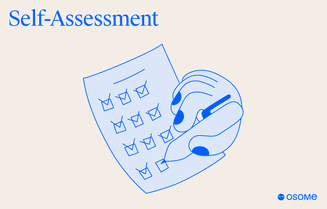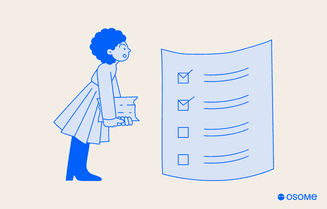Registering for Self Assessment: A Complete Guide
- Modified: 9 September 2024
- 8 min read
- Starting a Company


Gabi Bellairs-Lombard
Business Writer
Gabi is a content writer who is passionate about creating content that inspires. Her work history lies in writing compelling website copy, now specialising in product marketing copy. Gabi's priority when writing content is ensuring that the words make an impact on the readers. For Osome, she is the voice of our products and features. You'll find her making complex business finance and accounting topics easy to understand for entrepreneurs and small business owners.
If you’re searching for the answers to how to register for a Self Assessment tax return, look no further. This clear guide cuts through the confusion to help you swiftly navigate the HMRC registration process, whether you’re self-employed, a sole trader, a business director, or a partnership member.
Key Takeaways
- Self Assessment is a tax system used by HMRC in the UK where individuals report their income and expenses to pay the correct amount of tax, applicable to those who are self-employed or have untaxed income.
- Registering for Self Assessment to be complete by the 5th of October following the end of the tax year you began receiving untaxed income. Failure to inform HMRC by this deadline can result in penalties.
- The Self Assessment registration process varies for the self-employed, limited company directors, and partners in a partnership. All eligible taxpayers must register, accurately declare all taxable income, and submit their tax returns annually by the deadlines.
What Is a Self Assessment?
Self Assessment is a system utilised by the HM Revenue and Customs (HMRC) in the UK to collect Income Tax from individuals, primarily those running small businesses. This method is particularly relevant to those with income sources not yet known to HMRC or those who are self-employed. Simply put, if you’re earning money from various sources, you must inform HMRC and complete the necessary subsequent steps.
Registering for Self Assessment and submitting a tax return involves detailing all your income and expenses for the tax year. This includes reporting all your revenue sources, ranging from self-employment to property income, for example. It’s a way of declaring all your taxable earnings to ensure you pay tax in the right amount.
If you need assistance with Self Assessment registration or navigating the tax return process, our team is here to help you every step of the way.

Who Is Required To Register for Self Assessment?
You must register for Self Assessment with HMRC if you need to send a tax return that you didn’t send last year. You’re likely to need to submit a tax return if, in the last tax year (6th April 2023 to 5th April 2024), any of the following apply to you:
- You were self-employed as a sole trader and earned more than £1,000 (before subtracting any tax relief you can claim).
- You were a landlord and earned over £2,500 from the property (after deducting any allowable expenses).
- You were a partner in a partnership.
- Your total taxable income was above £100,000.
- You had to pay the High Income Child Benefit Charge.
- You received taxable foreign income.
If you’re unsure whether or not you need to file your tax return, it’s best to check with an accountant who can advise you. Our team of experts can assist you with registering for Self Assessment tax return through your business tax account and evaluating past sources of earnings to determine your income tax status. We file tax returns for business owners, whether you're a sole trader or director of a large corporation, so that they are on time and compliant and help them navigate all things tax-related, from how rental income should be taxed to paying National Insurance contributions.
How To Register for Self Assessment
Once you’ve established the need for registering for Self Assessment registration, you might wonder about the subsequent steps in the registration process. The registration steps vary depending on self-employment status, or if you're a company director or partner. But don’t fret — we’ve got you covered. Registering as a self-employed individual
If you’re self-employed, a sole trader, or simply run a small business, the first step to registering for Self Assessment involves creating a Government Gateway user ID. Once you’ve established this online account, you can then log into your business tax account and add Self Assessment to your services.
After registering, HMRC will send you an acknowledgement letter containing your Unique Taxpayer Reference (UTR) which will be used when you file tax returns. Following this, you’ll receive an Activation Code for the online services, which you must use within 28 days to activate the service. Completing these steps prepares you for accurate and timely submission of your tax returns.
Registering as a limited company director
Limited company directors may find the registration slightly more prolonged. But remember, the time taken is worth the effort, especially if you receive income in the form of:
- dividends
- directors’ loans
- benefits
- non-PAYE-taxed expenses
In such cases, you must register for Self Assessment as it allows HMRC to calculate your Income Tax accurately. This procedure maintains tax transparency, guaranteeing that you pay tax accurately.
Registering as a partner in a partnership
The registration process for partners in a partnership is slightly different. In a partnership, not only do the individual partners need to register for Self Assessment, but the company itself must also register.
The nominated partner, in particular, is responsible for managing the partnership’s tax affairs, which includes receiving and submitting the partnership’s tax return. When registering, it’s necessary to include details about the business and the partners themselves, such as the company name, address, trading name, nature of the business, and commencement date.
Self Assessment Registration Deadlines
Many people wonder about the registration times. The deadline is quite clear: you must be registered for Self Assessment by the 5th of October in the year following the end of the tax year in which you have income to report and haven’t previously done so. For example, if you are a self-employed individual and have a new source of untaxed earnings during the tax year, such as rental income, you should notify HMRC by the 5th of October following the end of that tax year.

But what happens if you’ve previously registered for Self Assessment but have not submitted a tax return for the last year? In such an instance, re-registration is necessary. Even if you have a Unique Taxpayer Reference (UTR) from previous filings, it is still necessary to inform HMRC by the 5th of October deadline if you must file a Self Assessment tax return for the previous year, especially if you are self-employed. If you’ve lost or forgotten your Unique Taxpayer Reference, you can request it from HMRC. This ensures compliance with HMRC regulations. It’s worth noting that a penalty may be charged for failure to notify HMRC by the deadline, although it might be reduced to zero if you pay your income tax liability in full by 31 January.
Penalties for Non-Compliance
You might wonder about the consequences of non-compliance with regulations. Well, penalties apply for non-compliance. Here are the penalties:
- If your tax return is up to 3 months late, a penalty of £100 is imposed
- Additional penalties accrue for returns more than 3 months overdue
- Interest is also applied to any late tax return filed, as well as any penalties for failure to file and pay taxes on time, including any outstanding income tax liability.
However, the situation is not entirely bleak. If you have a reasonable excuse for your late submission or payment, you can appeal against the penalties. That said, it’s best to avoid such situations by ensuring you meet all the deadlines and pay your taxes on time.
What Happens After You Register?
After your Self Assessment registration, the responsibility now lies with you. HMRC will provide you with a unique taxpayer reference (UTR) number, which identifies you in all future communication with HMRC. After receiving your UTR number and activation code, you will also receive a Government Gateway user ID. You can use this ID to log in and activate your business tax account. Now, you can file your annual tax return online using the government’s Self Assessment system.
Bear in mind that Self Assessment registration isn’t a one-off task, especially if you are self-employed. It’s a continuous obligation. You must accurately declare all taxable income, including national insurance contributions, and pay any applicable taxes by the deadlines HMRC sets. After all, staying on top of your tax affairs and maintaining a self assessment register is part of being a responsible citizen.
Preparing and Submitting Your Tax Return
With the registration complete and you have an active business tax account, the next step is to prepare and submit your tax return. This can be done either online or by post using form SA100. But organisation is key no matter how you file your return.
Keeping well-organised records of your income and expenses is crucial. This ensures that you’re reporting accurate information to HMRC and makes the process much smoother and less stressful. Once your records are in order (for example, bank statements or receipts), you can confidently submit your tax return at any time following the end of the tax year.
Seeking Professional Services
Managing tax affairs can be straightforward for some, but if you’re self-employed or have complicated financial circumstances, it might seem overwhelming. In these situations, professional online services can offer significant advantages.
Professional tax advisors or accountants can:
- Guide you through the complexities of tax laws
- Help you optimise your tax-free withdrawals
- Represent you during HMRC inquiries
- Stay up-to-date with frequent changes in tax legislation, ensuring compliance and reducing the burden on you
- Identify potential deductions when you file your tax return, potentially saving more than the cost of their services.
Summary
In conclusion, understanding Self Assessment and the registration procedure is crucial for individuals with multiple income sources. Whether you’re self-employed, a company director, or a partner in a partnership, it’s your responsibility to report all your income to HMRC and pay the correct amount of tax. Remember, while the process might seem daunting at first, with a clear understanding and perhaps the assistance of a professional, it becomes manageable. It is important to take responsibility for your tax obligations, abide by regulations, and contribute your fair share to the country's finances.
FAQ
How do I get my UTR number for the first time?
To get your UTR number for the first time, you must register for HMRC's online service, wait for HMRC to send your UTR number in the post, and then enrol for Self Assessment. Afterwards, HMRC will send your UTR activation code in the post, typically within 1 week.
How do I sign up for self assessment with personal tax?
To register for Self Assessment with personal tax, you can complete the form online through your HMRC account or print it out and post it to HMRC. Make sure to create an online account with HMRC even if you choose to print and post the form.
Can I re-register for Self Assessment online?
Yes, you can re-register for Self Assessment online using a CWF1 form and your UTR. If you've registered before but did not send a tax return the preceding year, you must register again.
Who needs to register for Self Assessment?
If you are self-employed, a limited company director, a partner in a partnership, or have untaxed income, you must register for Self Assessment and file the relevant tax return on time. This ensures compliance with tax regulations and avoids penalties.
When is the deadline to register for Self Assessment?
The deadline to register for Self Assessment is October 5th of the year following the end of the tax year, which is when you have income to report. You must meet this deadline if you need to complete a Self Assessment tax return and have not sent one before. You could face a fine if you do not comply with this deadline.
How long does it take to register for Self Assessment?
The process of registering for Self-Assessment in the UK typically takes around 10 working days if you're registering online. However, it may take longer if you choose to register by mail or if HM Revenue and Customs (HMRC) requires additional information. After registering, you'll receive a Unique Taxpayer Reference (UTR) and instructions on how to complete your tax return. It's important to register for Self-Assessment as soon as you become self-employed or if you have other income sources requiring you to file a tax return.
More like this
Get expert tips and business insights
By clicking, you agree to our Terms & Conditions, Privacy and Data Protection PolicyWe’re using cookies! What does it mean?






